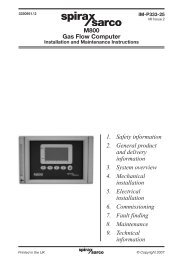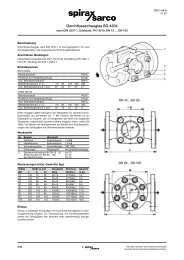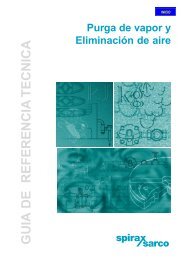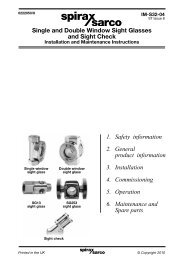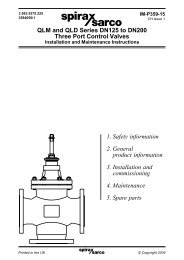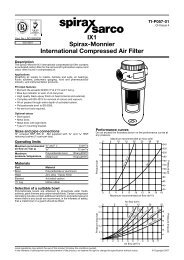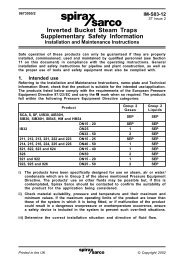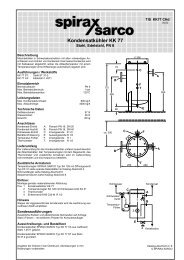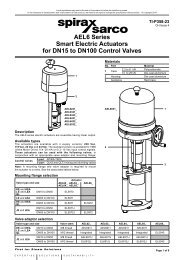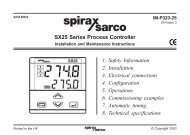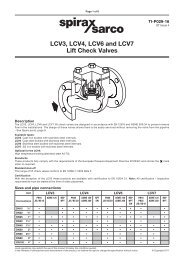2000 Hook-up Book - Spirax Sarco
2000 Hook-up Book - Spirax Sarco
2000 Hook-up Book - Spirax Sarco
You also want an ePaper? Increase the reach of your titles
YUMPU automatically turns print PDFs into web optimized ePapers that Google loves.
SYSTEM DESIGN<br />
12<br />
Steam Tracing<br />
The temperature of process liquids<br />
being transferred through pipelines<br />
often must be maintained to meet<br />
the requirements of a process, to<br />
prevent thickening and solidification,<br />
or simply to protect against<br />
freeze<strong>up</strong>. This is achieved by the<br />
use of jacketed pipes, or by attaching<br />
to the product line one or more<br />
separate tracer lines carrying a<br />
heating medium such as steam or<br />
hot water.<br />
The steam usage may be relatively<br />
small but the tracing<br />
system is often a major part of<br />
the steam installation, and the<br />
source of many problems.<br />
Many large users and plant<br />
contractors have their own<br />
inhouse rules for tracer lines, but<br />
the following guidelines may be<br />
useful in other cases. We have<br />
dealt only with external tracing,<br />
this being the area likely to cause<br />
difficulties where no existing<br />
experience is available. External<br />
tracing is simple and therefore<br />
cheap to install, and fulfills the<br />
needs of most processes.<br />
External Tracer Lines<br />
One or more heat carrying lines, of<br />
sizes usually from 3/8" <strong>up</strong> to 1"<br />
nominal bore are attached to the<br />
main product pipe as in Fig. 6.<br />
Transfer of heat to the product line<br />
may be three ways—by conduction<br />
through direct contact, by convection<br />
currents in the air pocket<br />
formed inside the insulating jacket,<br />
and by radiation. The tracer lines<br />
may be of carbon steel or copper,<br />
or sometimes stainless steel.<br />
Where the product line is of a<br />
particular material to suit the fluid<br />
it is carrying, the material for the<br />
tracer line must be chosen to<br />
avoid electrolytic corrosion at any<br />
contact points.<br />
For short runs of tracer, such<br />
as around short vertical pipes, or<br />
valves and fittings, small bore copper<br />
pipes, perhaps 1/4" bore may<br />
be wound around the product lines<br />
as at Fig. 7. The layout should be<br />
arranged to give a continuous fall<br />
along the tracers as Fig. 9a rather<br />
than Fig. 9b, and the use of wrap<br />
around tracers should be avoided<br />
on long horizontal lines.<br />
A run of even 100 ft. of 6 inch<br />
product line will have a total of<br />
about 500 to 600 ft. of wrap<br />
around tracer. The pressure drop<br />
along the tracer would be very<br />
high and the temperature at the<br />
end remote from the s<strong>up</strong>ply would<br />
be very low. Indeed, this end of<br />
the tracer would probably contain<br />
only condensate and the temperature<br />
of this water would fall as it<br />
gives <strong>up</strong> heat. Where steam is<br />
present in the tracer, lifting the<br />
condensate from the multiplicity of<br />
low points increases the problems<br />
associated with this arrangement.<br />
Figure 7<br />
Small Bore Tracing<br />
Wraped Around<br />
Vertical Product Line<br />
Figure 8<br />
Clipping Tracer Around Bends<br />
Product<br />
Tracer<br />
Lagging<br />
Aluminum<br />
Foil<br />
Air Space<br />
Figure 6<br />
Tracer Attached To Product Line<br />
Figure 9 Continuous Fall On Wrap Around Tracer<br />
9a 9b<br />
Figure 10 Attaching Tracer To Line<br />
Figure 10a Short Run Welds<br />
Figure 10b Continuous Weld<br />
Lagging<br />
Heat<br />
Conducting<br />
Paste<br />
Product<br />
Tracer<br />
Figure 10c Heat Conducting Paste



